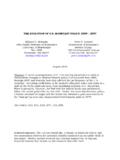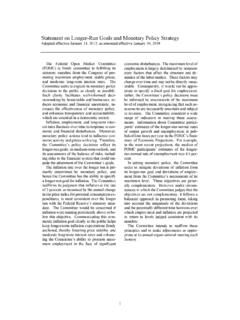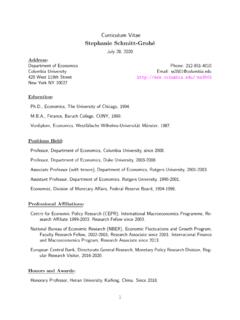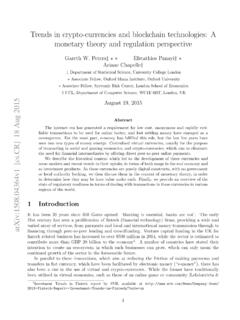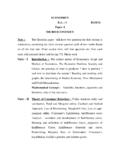Transcription of Journal of Monetary Economics - Columbia University
1 On quality bias and inflation targetsStephanie Schmitt-Grohe a,b,c, Mart n Uribea,b,naDepartment of Economics , Columbia University , 420 West 118th Street MC3308, NY 10027, United StatesbNBER, United StatescCEPR, United Kingdomarticle infoArticle history:Received 5 November 2009 Received in revised form21 February 2012 Accepted 21 February 2012 Available online 1 April 2012abstractDoes Ramsey optimal policy call for adjusting the inflation target by the size of thequality bias in measured inflation? We find that if it is nonhedonic (or sticker) pricesthat are sticky, the conventional view, according to which it is optimal to adjust theinflation target upward by the size of the quality bias, is misguided.
2 Furthermore, weestablish that quality improvement is crucial for the determination of the optimalinflation target even in the absence of quality bias. In this case, if nonhedonic prices aresticky, sticker prices should fall at the rate of quality Elsevier All rights IntroductionThe existence of a positive quality bias in the consumer price index has led some to argue that an inflation target equalin size to the bias would be appropriate if the ultimate objective of the central bank is price stability. For early articulationsof this view seeBernanke and Mishkin (1997)andCamba-Mendez (2003). Over the past ten years, the conventionalwisdom in this regard has little changed.
3 In a November 14, 2007 speech at the Cato Institute s 25th Annual MonetaryConference, Ben Bernanke, Chairman of the Board of Governors of the Federal Reserve System, stated: Were price stabilitythe only objective mandated for the Federal Reserve, the FOMC presumably would strive to achieve zero inflation, properlymeasured that is, the optimal measured inflation rate would deviate from zero on average only by the amount of theestimated measurement error in the preferred inflation index. This paper critically evaluates this argument. Specifically, it studies whether a central bank implementing Ramsey-optimal policy would adjust its inflation target to account for the systematic upward bias in measured inflation due toquality improvements in consumption goods.
4 The paper shows that the answer to this question depends critically uponthe nature of the assumed price stickiness. If nonquality-adjusted (or sticker) prices are sticky, then according to theRamsey policy the inflation target should not be corrected; , in this case the central bank should not target a quality-adjusted index such as a cost-of-living index (COLI). On the other hand, if quality-adjusted (or hedonic) prices are sticky,then the inflation target should be raised by the magnitude of the bias; , in this case the central bank should target zerogrowth in a quality-adjusted index. The intuition is straightforward: optimal policy aims at keeping the assumed-stickyprices whatever those prices are constant over time, to avoid inefficient price quality bias in the consumer price index has been studied and documented by both policymakers andacademic researchers.
5 In 1995, the Senate Finance Committee appointed an advisory commission composed of fiveprominent academic economists (Michael Boskin, Ellen Dulberger, Robert Gordon, Zvi Griliches, and Dale Jorgenson) toContents lists available atSciVerse ScienceDirectjournal of Monetary Economics0304-3932/$-see front matter&2012 Elsevier All rights author at: Department of Economics , Columbia University , 420 West 118th Street MC3308, NY 10027, United : 1 212 851 (M. Uribe). Journal of Monetary Economics 59 (2012) 393 400study the magnitude of the measurement error in the consumer price index. The commission concluded that over theperiod 1995 1996, the CPI had an upward bias of per year.
6 Of the total bias, was ascribed to unmeasuredquality improvements (seeBoskin et al., 1996).To illustrate the nature of the quality bias, consider the case of a personal computer. Suppose that between 1995 and1996 the nominal price of a computer increased by 2%. Assume also that during this period the quality of personalcomputers, measured by attributes such as memory, processing speed, and video capabilities, increased significantly. If thestatistical office in charge of constructing the consumer price index did not adjust the price index for quality improvement,then it would report 2% inflation in personal computers. However, because a personal computer in 1996 provides moreservices than does a personal computer in 1995, the quality-adjusted rate of inflation in personal computers should berecorded as lower than 2%.
7 The difference between the reported rate of inflation and the quality-adjusted rate of inflationis called the quality bias in measured relationship between quality improvement and the Ramsey optimal rate of inflation is analyzed in the context of aneo-Keynesian model withCalvo (1983)andYun (1996)price staggering. The key modification introduced to thatframework is that the quality of consumption goods is assumed to increase over time. This modification gives rise to aninflation bias if the statistical agency in charge of constructing the consumer price index fails to take quality improvementsinto account. The central question entertained in the present study is whether under Ramsey optimal policy the inflationtarget should be adjusted by the size of this paper finds that as long as nonhedonic (or sticker) prices are sticky, the conventional view, according to which it isoptimal to adjust the inflation target upward by the size of the quality bias, is misguided.
8 Furthermore, qualityimprovement is crucial for the determination of inflation targets even in the absence of quality bias in consumer , in this case, if nonquality-adjusted (or sticker) prices are sticky, the optimal inflation target is indeed negativeand equal in absolute value to the rate of quality paper contributes to a body of work that is concerned with explaining the observed positive inflation targets ofcentral banks. For a survey of this literature, seeSchmitt-Grohe and Uribe (2011a). Among the reasons given in the existingliterature for targeting positive inflation are (1) The zero bound on nominal interest rates, which creates the need forsetting positive rates of inflation as a way to preserve the central bank s ability to stimulate the economy (Summers, 1991;Reifschneider and Williams, 2000;Adam and Billi, 2006).
9 (2) Downward price and wage rigidity. When nominal product orfactor prices are downwardly rigid, any efficient change in relative prices calls for an increase in the price level (Olivera,1964;Tobin, 1972). A related argument is presented inWolman (2011). He shows that in a two-sector economy withdifferent rates of long-run productivity growth, the optimal rate of inflation is positive if nominal prices are relatively moreflexible in the sector with the lower rate of productivity growth. (3) Inflation as a levy on untaxed income. The sources ofuntaxed income may take different forms, including the underground economy (Nicolini, 1998), pure monopoly rents(Schmitt-Grohe and Uribe, 2004), and a foreign demand for money (Schmitt-Grohe and Uribe, forthcoming).
10 These theoriescoexist with others that suggest the optimality of either zero inflation in the context of New-Keynesian frameworks(Goodfriend and King, 1997), or negative inflation, in the context of models with a demand for money (Friedman, 1969).Our work suggests that quality change is a justification for a positive inflation target only if price stickiness affects mainlyquality-adjusted prices and if the statistical agency fails to fully correct for the quality remainder of the paper is organized in four 2presents a simple neo-Keynesian model of qualitybias in measured 3characterizes Ramsey-optimal Monetary policy when nonquality-adjusted prices areassumed to be 4characterizes Ramsey-optimal Monetary policy when quality-adjusted (or hedonic)










